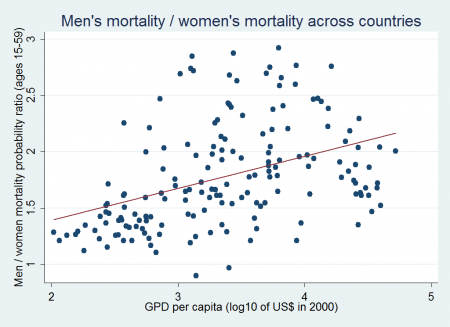Men are more likely than women to die before reaching a ripe old age. Consider persons ages 15 to 59, divided into men and women. In 2010, across 187 countries for which data are available, only three countries had an estimated mortality for men that was less than the corresponding figure for women.[1] In 125 countries, men’s probability of death was 50% or more than women’s. Men’s lowest relative probability of death was in Honduras, at 90% that of women. Men’s highest relative probability of death was in Estonia, at nearly three times that of women. Across 187 countries encompassing most of the world, the median mortality sex ratio implies men had a 64% higher probability of dying than women did.

Countries with higher income per capita tend to have a higher probability of men dying relative to women dying. A simple linear estimation implies that a 10% increase in average monetary income per capital is associated with a 1.3% increase in the probability of a man’s death relative to a woman’s death among persons ages 15 to 59.[2]
Consistent with the cross-sectional correlation and economic growth over time, the median mortality sex ratio increased from 1970 to 2010. In 1970, the median ratio implies a 40% higher death probability for men relative to the death probability for women among persons ages 15 to 59. Men’s death-probability gender protrusion rose to 64% in 2010.
International development scholars and agencies show little concern for men’s relatively greater mortality, and for men’s welfare more generally. Men’s distinctive individual biology does not imply that men are destined for gender inequality in death. The growth of that gender inequality, and lack of concern about it, seems to be a deep structure of human social development.
* * * * *
Read more:
- men’s greater injury-related mortality prompts pathologizing masculinity
- burdens of manliness in elite legal discourse
- massaging gender gaps for international development
Data: international sex differences in mortality workbook (Excel version)
Notes:
[1] Rajaratnam et al. (2010) developed sex-specific mortality rates for persons ages 15-59 (45q15) for 187 countries by year from 1970 to 2010. Those data are available from the Institute for Health Metrics and Evaluation (IHME). The data for 1970 and 2010 are compiled in a more accessible, more linkable format in the international sex differences in mortality workbook. Similar data for sex-specific expected lifespans are developed in Wang et al. (2012), but those data are not readily accessible online. IMHE provides a variety of data visualizations, including a mortality visualization. The problem of sex differences in mortality isn’t mainly a problem of data visualization, but one of social communication.
[2] Average monetary income per capita is measured here as gross domestic product per capita (GDP per capita). The GDP per capita figures are from the World Bank’s World Development Indicators.
References:
Rajaratnam, Julie Knoll, Jake R Marcus, Alison Levin-Rector, Andrew N Chalupka, Haidong Wang, Laura Dwyer, Megan Costa, Alan D Lopez, and Christopher JL Murray. 2010. “Worldwide mortality in men and women aged 15–59 years from 1970 to 2010: a systematic analysis.” The Lancet. 375 (9727): 1704-1720.
Wang, Haidong, Laura Dwyer-Lindgren, Katherine T Lofgren, Julie Knoll Rajaratnam, Jacob R Marcus, Alison Levin-Rector, Carly E Levitz, Alan D Lopez, and Christopher JL Murray. 2012. “Age-specific and sex-specific mortality in 187 countries, 1970–2010: a systematic analysis for the Global Burden of Disease Study 2010.” The Lancet. 380 (9859): 2071-2094.